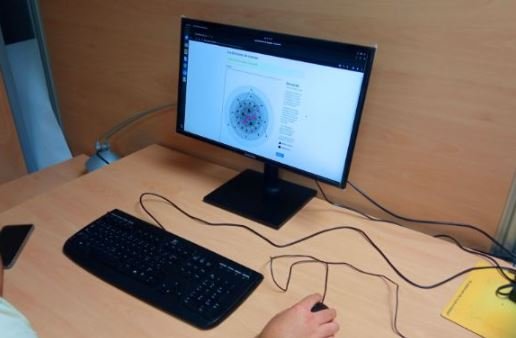
The way we adopt new ideas or technologies is not solely influenced by our immediate circle of friends and family. A recent study has revealed that even people with whom we do not interact directly can significantly influence our decisions.
Researchers from the Polytechnic University of Madrid (UPM), the Institute for Cross-Disciplinary Physics and Complex Systems (IFISC, UIB-CSIC), and the Carlos III University of Madrid (UC3M) have experimentally demonstrated that indirect connections in a social network have a significant impact on the adoption of innovations. The study, published in the journal PNAS Nexus, reveals that the influence of indirect contacts is approximately two-thirds and one-third that of direct contacts for the second and third circles of influence, respectively.
Deciphering the complexity of innovation diffusion
The adoption of new ideas, practices, or technologies is a complex process influenced by a wide range of factors. While traditional models often focus on direct interpersonal interactions, recent research suggests that the diffusion of innovations is determined by a much broader network of social connections.
Social networks, consisting of individuals connected by interpersonal relationships, play a crucial role in the diffusion of innovations. These networks can facilitate the exchange of information, influence decision-making, and foster trust and cooperation. However, understanding the complexities of these networks is essential to fully comprehend the dynamics of innovation diffusion.
Beyond direct ties: The power of indirect influence
Traditional models of innovation diffusion typically focus on the role of direct social interactions. These models assume that our decisions are primarily shaped by the people we know and regularly interact with. However, new research suggests that this assumption is overly simplistic.
One of the key findings of recent research is the significant impact of indirect influences on innovation adoption. While direct interactions, such as face-to-face conversations or email exchanges, are undoubtedly important, people can also be influenced by the behavior of others they observe indirectly. This phenomenon, known as “social” or “observational” learning, can be particularly powerful in shaping attitudes and behaviors.
To quantify the influence of both direct and indirect connections, the researchers developed the concept of social distance. Social distance measures the closeness or intimacy that an individual or group feels toward another individual. In the context of innovation diffusion, social distance can be interpreted as the number of links separating two individuals in their network of interpersonal channels.
The power of indirect influence
To fully understand the scope of social influence on innovation adoption, the researchers conducted a series of experiments involving more than 590 participants. They created artificial social networks and then introduced new “innovations” to the participants. By tracking how these innovations spread through the networks, the researchers were able to measure the impact of both direct and indirect influences.
The experiment was carried out in four different settings, providing participants with information about the color choices of their direct contacts but also of those at greater social distances. In other words, they not only knew what colors their “friends” chose but also those chosen by the “friends of their friends.” The researchers used a mathematical model that accounts for both direct and indirect interactions in the network to adjust the experimental results and determine how influence decays with social distance.
The results were surprising.
Not only did direct ties play an important role, but individuals were also influenced by people who were two or three degrees of separation away. In other words, even people we do not know personally can exert a powerful influence on our decisions.
“We have not found experiments that investigate this effect in controlled environments, so we decided to do it ourselves,” says Anxo Sánchez, a researcher from the Interdisciplinary Group of Complex Systems (GISC) at UC3M. Participants had to choose between two colors, with one representing “tradition” and the other “innovation,” with the goal of reaching a global consensus. “Our results show that the adoption of an innovation is a complex process in which an individual feels significant pressure not only from their direct connections but also from those socially close,” explains Manuel Miranda, a researcher at IFISC and the study’s lead author.
The decay of influence
To quantify the strength of these indirect influences, the researchers developed a mathematical model. This model allowed them to estimate how the influence of a person decays with social distance. They found that, while the strongest influence comes from our immediate circle of friends and family, the influence of people who are two degrees of separation away remains substantial. In fact, it is estimated to be approximately two-thirds as strong as the influence of our closest neighbors.
“This study challenges the common assumption that only direct interactions determine the dynamics of innovation adoption,” adds IFISC researcher Ernesto Estrada. “We have shown that individuals are also significantly influenced by their second and third circle of contacts.”
Implications for innovation
The findings of this study have important implications for understanding and promoting innovation. By recognizing the power of indirect influences, we can develop more effective strategies for spreading new ideas and technologies. For instance, companies can target not only their immediate customers but also those who are likely to influence their decisions. Additionally, policymakers can design programs that leverage social networks to encourage the adoption of beneficial innovations.
This interdisciplinary work combines experimental methods with advanced mathematical models to shed light on the complex processes of social influence in the diffusion of innovations. “These results are obtained by treating all ‘friends’ as an indistinguishable group. Resolving and attempting to predict this influence at an individual level will require further work,” says María Pereda, a researcher at UPM.
Conclusion
The researchers conclude that this study opens new avenues for investigating how innovations spread in social networks and suggests that strategies to accelerate the adoption of new ideas or technologies should consider not only direct connections but also the influence of broader social circles.
Contact
Manuel Miranda
Instituto de Física Interdisciplinar y Sistemas Complejos IFISC (UIB-CSIC)
Palma de Mallorca 07122, Illes Balears, Spain
Email: mmiranda@ifisc.uib-csic.es
Ernesto Estrada
Email: estrada@ifisc.uib-csic.es
Reference (open access)
Manuel Miranda, María Pereda, Angel Sánchez, Ernesto Estrada, Indirect social influence and diffusion of innovations: An experimental approach, PNAS Nexus, Volume 3, Issue 10, October 2024, pgae409, https://doi.org/10.1093/pnasnexus/pgae409
Editor and founder of “Innovar o Morir” (‘Innovate or Die’). Milthon holds a Master’s degree in Science and Innovation Management from the Polytechnic University of Valencia, with postgraduate diplomas in Business Innovation (UPV) and Market-Oriented Innovation Management (UPCH-Universitat Leipzig). He has practical experience in innovation management, having led the Fisheries Innovation Unit of the National Program for Innovation in Fisheries and Aquaculture (PNIPA) and worked as a consultant on open innovation diagnostics and technology watch. He firmly believes in the power of innovation and creativity as drivers of change and development.





